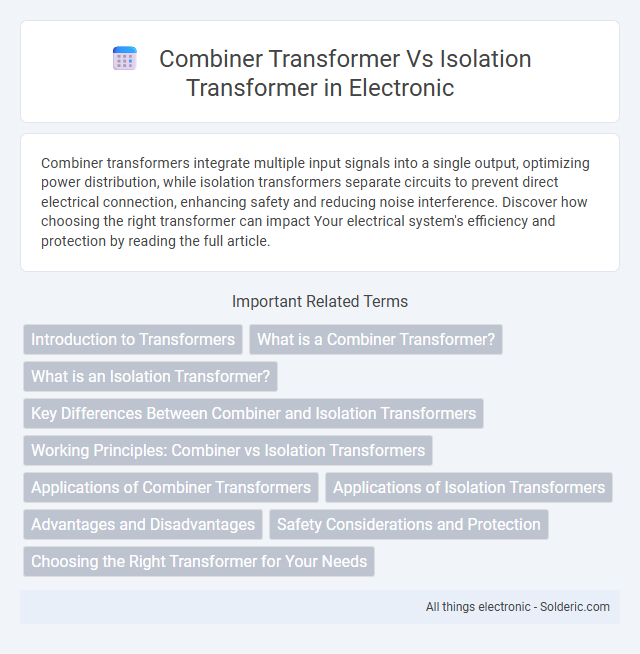Combiner transformers integrate multiple input signals into a single output, optimizing power distribution, while isolation transformers separate circuits to prevent direct electrical connection, enhancing safety and reducing noise interference. Discover how choosing the right transformer can impact Your electrical system's efficiency and protection by reading the full article.
Comparison Table
| Feature | Combiner Transformer | Isolation Transformer |
|---|---|---|
| Primary Use | Combines multiple inputs into a single output | Electrically isolates input from output for safety and noise reduction |
| Functionality | Combines power or signal sources | Provides galvanic isolation and voltage transformation |
| Electrical Isolation | Limited or none | Complete galvanic isolation |
| Application | Power distribution combining multiple inputs (e.g., solar arrays) | Medical equipment, industrial safety, noise reduction in sensitive electronics |
| Voltage Transformation | Usually none or minimal | Step-up or step-down voltage as needed |
| Noise Reduction | Minimal | Significant; isolates noise and transients |
| Safety | Does not provide isolation for safety | Enhances safety by isolating circuits |
| Cost | Generally lower | Typically higher due to added isolation features |
Introduction to Transformers
Combiner transformers efficiently merge multiple input power sources into a single output, ensuring synchronized voltage and phase alignment for complex electrical systems. Isolation transformers provide galvanic isolation between input and output circuits, enhancing safety by preventing direct electrical connection and reducing noise interference. Both transformers are essential in power distribution, with combiners optimizing multi-source integration and isolation transformers safeguarding sensitive equipment.
What is a Combiner Transformer?
A combiner transformer is an electrical device designed to merge multiple input signals or power sources into a single output while maintaining isolation between circuits. It optimizes signal integrity and reduces interference by combining frequencies or voltages efficiently. You benefit from improved system performance and simplified wiring when using a combiner transformer instead of an isolation transformer, which primarily focuses on preventing direct electrical connection for safety.
What is an Isolation Transformer?
An isolation transformer is a device designed to transfer electrical power while isolating the primary circuit from the secondary circuit, enhancing safety by preventing direct electrical connection. It reduces electrical noise, limits voltage spikes, and protects sensitive equipment by providing galvanic isolation. You can use isolation transformers in medical devices, industrial systems, and electronics to ensure stable and safe power supply.
Key Differences Between Combiner and Isolation Transformers
Combiner transformers consolidate multiple input sources into a single output, optimizing power distribution and simplifying wiring in systems with parallel inputs. Isolation transformers, on the other hand, provide galvanic isolation between primary and secondary windings, enhancing safety by preventing direct electrical connection and reducing noise interference. Understanding these key differences helps you select the appropriate transformer type for your application based on isolation needs versus power combining requirements.
Working Principles: Combiner vs Isolation Transformers
Combiner transformers work by merging multiple input signals or power sources into a single output, optimizing load sharing and signal distribution. Isolation transformers function by electrically separating the input from the output, providing safety and noise reduction through magnetic coupling without direct electrical connection. Understanding these working principles helps you choose the right transformer for efficient power management or signal integrity in your system.
Applications of Combiner Transformers
Combiner transformers are primarily used in telecommunications and signal processing systems to merge multiple input signals into a single output without interference, ensuring signal integrity. These transformers facilitate efficient power distribution in parallel circuits and are essential in RF applications for combining antenna signals. Your communication systems benefit from combiner transformers by improving performance and reducing signal loss in multi-channel configurations.
Applications of Isolation Transformers
Isolation transformers are primarily used in medical equipment, sensitive electronic devices, and industrial control systems to prevent electrical shock and reduce noise interference. Their ability to isolate the input from output enhances safety and protects your devices from voltage spikes and ground loops. Common applications include powering laboratory instruments, telecommunication systems, and audio equipment where stable and clean power supply is critical.
Advantages and Disadvantages
Combiner transformers offer the advantage of effectively merging multiple input signals into a single output, improving signal efficiency and reducing the need for separate wiring, but they may introduce signal distortion or interference if not properly designed. Isolation transformers provide excellent protection by electrically separating the input and output, which enhances safety and reduces noise interference, yet they tend to be bulkier and more expensive compared to combiner transformers. Your choice depends on whether you prioritize signal integration and cost-efficiency or enhanced safety and noise isolation in your electrical setup.
Safety Considerations and Protection
Isolation transformers enhance safety by electrically separating input and output, reducing shock hazards and preventing ground loop interference, while combiner transformers primarily focus on combining multiple input sources. Safety features in isolation transformers include galvanic isolation and reduced risk of electric shock, making them essential in sensitive equipment and medical environments. Combiner transformers, lacking this isolation, require additional protective devices to ensure electrical safety and fault protection.
Choosing the Right Transformer for Your Needs
Choosing the right transformer depends on the specific application requirements, where combiner transformers efficiently combine multiple input signals into one output, optimizing signal distribution in telecommunications or audio systems. Isolation transformers, on the other hand, prioritize safety and noise reduction by electrically separating circuits, making them ideal for sensitive electronic equipment and preventing ground loops. Understanding your system's needs for signal integration versus electrical isolation ensures your selection enhances performance and protects your devices effectively.
combiner transformer vs isolation transformer Infographic

 solderic.com
solderic.com